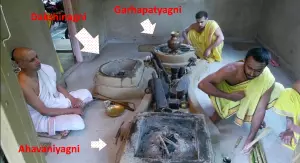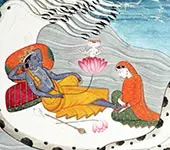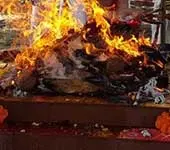Agnihotra

What is Agnihotra?
As per the Vedic tradition, a householder is supposed to set up sacred Agnis and maintain them unextinguished.
These Agnis are maintained in three kundas and they are called Garhapatyagni, Ahavaniyagni, and Dakshinagni.
Click below to watch Original Vedic Agnihotra
The following yajnas are performed with these fires.
- Darsha-Purnamasa - performed in connection with Amavasya and Purnima every month.
- Chaturmasya - performed once in four months.
- Agrayana - Performed twice a year when grains are harvested.
- Nirudha-pashubandha - Animal sacrifice done once a year.
- Sautramani - Yajna meant for Indra involving sacrifice 3 or 5 animals.
These are called Haviryajnas.
In addition to these, Somayagas are also performed at least once in a lifetime.
The Somayagas are:
- Jyotishtoma or Agnishtoma
- Atyagnishtoma
- Ukthyam
- Shodashi
- Vajapeya
- Atiratram
- Aptoryama
There are many more yajnas meant for specific purposes such as Dvadashaha, Gavamayana, Vajapeya, Rajasuya, Ashhvamedha, Purushamedha, and Sarvamedha.
They are very elaborate and spread over many days.
In order to successfully perform these yajnas, the Agni has to be powerful.
That is the reason Agni needs to be maintained unextinguished and worshiped throughout.
This daily worship of Agni is called Agnihotra.
Agnihotra involves offerings of milk in the evening and morning every day and prayers.
What is Agnyadheyam?
The first time setting up of the sacred Agnis is called Agnyadheyam.
Who is a Yajamana?
Yajamana is the title of the person who performs the yajna.
He is the sponsorer of yajna. Purohitas (Ritwiks) perform the yajnas on behalf of the Yajamana.
Yajamana and his wife also have to perform certain parts of the yajna.
Who should perform Agnihotra?
The Yajamana and his wife should be present while Agnihotra is performed.
On Amavasya and Purnima, the Yajamana himself should give Agnihotra offerings.
On other days a someone else can do this on his behalf.
Agnihotra timings
The evening Agnihotra is performed just before or after sunset.
The morning Agnihotra is performed just before or after sunrise.
Are all the three Agnis maintained perpetually?
It depends on which Shrauta Sutra is being followed by the Yajamana.
There are slight variations between Sutras.
The variations are :
- All three Agnis are maintained perpetually.
- Only Garhapatya and Dakshninagni are maintained perpetually. At the time of Agnihotra, a portion of the Agni from Garhapatya kunda is transferred to Ahavaniya kunda.
- Only Garhapatyagni is maintained perpetually. Agni is transferred to the other kundas from Garhapatya at the time of Agnihotra. In the case of Dakshinagni the procedure through which it was generated at the time of Agnyadheyam is to be followed; the other two being; generation through the churning of arani or getting it from a neighbor or fireplace.
What are Shrauta sutras?
Shrauta sutras are texts which give the procedure of yajnas.
Examples are Apastamba Shrauta sutra, Baudhayana Shrauta sutra, Vaikhanasa Shrauta sutra.
These are to be used along with Brahmanam texts which give more insights into the procedures.
Agnihotra procedure
- All the three Agnis are ignited following one of the above procedures.
- Fuel in the form of firesticks (samidha) are added. This should be done before sunset and sunrise respectively.
- The cow is milked and milk brought the yaga shala.
- Water is sprinkled around all the three Agni kundas.
- Milk is heated either upon embers drawn from Garhapatyagni and kept to the north of it or upon the Ganhapatyagni itself.
- The performer gazes at the heated milk with the help of burning darbha blades with an intention to purify it.
- A little water is added to the milk.
- After the milk is heated, it is allowed to cool
- Four spoonfuls of milk are taken in the Agnihotra-ladle.
- The ladle is supported by a firestick and taken to the Ahavaniyagni.
- The firestick is placed in the Ahavaniyagni.
- The first portion of the milk is offered on that firestick to Agni in the case of Evening Agnihotra and Surya in the case of Morning Angnihotra. The second portion is offered to Prajapati in both cases. Appropriate mantras are chanted before making the offering.
- The ladle is wiped with darbha grass and milk sticking to it is removed.
- The remaining milk is drunk by the Yajamana.
- Water is poured into the ladle and then poured out into the folded hands of the wife of the Yajamana.
- Prayers are chanted.
- The cow which was milked is prayed to by the Yajamana chanting appropriate mantras.
- Yajamana comes back and prays to Agni again for blessings.
Agnihotra Mantra
Agnihotra sunset mantra
अग्निर्जोयोतिर्ज्योतिरग्निः स्वाहा।
Agni is light, light is Agni..Svaha
Agnihotra mantra sunrise
सूर्य्योज्योतिर्ज्योतिः सूर्य्यः स्वाहा।
Surya is light, light is Surya..Svaha
Agnihotra Prayers
उपप्रयन्तो अध्वरं मन्त्रं वोचेमाग्नये आरे अस्मे च शृण्वते।
As we perform this yajna, we are chanting mantra addressed to Agni.
Its effect should be felt far and near.
अग्निर्मूर्द्धा दिवः ककुत्पतिः पृथिव्या अयम्।
अपां रेतांसि जिन्वति॥
This Agni itself is in the sky as Surya.
He causes rain which makes plants to grow.
It is with their produce, offerings are given. In this manner, Agni himself is producing his offerings.
उभा वामिन्द्रागी आहुवध्या उभा राधसः सहमादयध्यै।
उभा दाताराविषां रयीणां उभा वाजस्य सातये हुवे वाम्॥
Oh, Agni! Oh, Indra! You both are providers of food and wealth.
I want to please you both with these offerings.
अयं ते योनिर् ऋत्वियो यतो जातो अरोचथाः।
तं जानन्नग्न आरोहाथा नो वर्द्धया रयिम्॥
The Garhapatyagni is the place of origin of Ahavaniyagni.
May Ahavaniyagni at the end of this karma reenter his place of origin.
We will take him out again for the next karma.
May he increase our wealth so that we can keep on performing yajnas.
अयमिह प्रथमो धायि धातृभिर्होता यजिष्ठो अध्वरेष्वीड्यः।
यमप्नवानो भृगवो विरुरुचुर्वनेषु चित्रं विश्वं विशे विशे॥
Ahavaiya is the main Agni.
He is praised so in yagas such as Somayaga.
He is the Lord.
Munis of Bhriguvamsha kindled him in the forest for the benefit of every Yajamana.
अस्य प्रत्नामनु द्युतं शुक्रं दुदुह्रे अह्रयः ।
पयः सहस्रसामृषिम् ॥
Cows are pure.
It is the brilliance of Agni which comes out of their udder as milk.
Milk and milk products increase Agni's brilliance in yajnas.
Surya is Agni. Sunlight causes photosynthesis producing food in plants.
Cows eat plants and produce milk.
This is the concept here. It is a cycle.
तनूपा अग्नेऽसि तन्वं मे पाहि।
आयुर्दा अग्नेऽस्यायुर्मे देहि।
वर्चोदा अग्नेऽसि वर्चो मे देहि।
अग्ने यन्मे तन्वा ऊनं तन्मे आपृण॥
Being present in the stomach as digestive fire, Agni nourishes and protects the body.
The body is alive only as long as Agni is present in it as heat.
Yajna is performed with the help of Agni.
Performance of yajna gives Brahmavarchas (spiritual aura).
Oh, Agni! Protect my body, give me long life, give me spiritual aura.
इन्धानास्त्वा शतं हिमा, द्युमन्तं समिधीमहि।
वयस्वन्तो वयस्कृतं सहस्वन्तः सहस्कृतम्।
अग्ने सपत्नदम्भनमदब्धासो अदाभ्याम्।
चित्रावसो स्वस्ति ते पारमीशय॥
Oh, Agni! We are brilliant because of your brilliance.
We are strong because of your strength.
We have food because you give us food.
We don't have enemies because you are the destroyer of enemies.
Our nights will be safe because we are under the protection of Agni.
सं त्वमग्ने सूर्य्यस्य वर्चसाऽगथाः समृषीणां स्तुतेन सं प्रियेण धाम्ना।
समहमायुषा सं वर्चसा सं प्रजया सं रायस्पोषेण सग्मिषीय॥
Oh, Agni! Sun's brilliance enters into you at night.
You have the power given to you by all the praises.
You have the strength of the offerings made unto you.
With your blessings, may I also have long life, knowledge, children, and wealth.
Prayer to the cows
आन्ध स्वान्धो वो भक्षीय मह स्थ महो वो भक्षीय ऊर्जस्थोर्जं वो भक्षीय
रायस्पोष स्थ रायस्पोषं वो भक्षीय।
You have with you, food in the form of milk and ghee.
That's how we have food. You are worshiped.
You are with us.
That's how we also earn respect. You are strong.
That's why we are also strong.
You are energetic.
That's why we are also energetic.
You are our wealth.
That's why we are wealthy.
रेवती रमध्वमस्मिन् योनावस्मिन् गोष्ठेऽस्मिंल्लोकेऽस्मिन् क्षये इहैव स्त मापगात्।
You move around here freely. Don't move far away.
Prayer to Garhapatyagni
उप त्वाग्ने दिवे दिवे दोषावस्तर्धिया वयम्।
नमो भरन्त एमसि॥
राजन्तमध्वराणां गोपामृतस्य दीदिवम्।
वर्द्धमानं स्वे दमे॥
स नः पितेव सूनवेऽग्ने सूपायनो भवे।
सचस्वा नः स्वस्तये॥
Oh, Agni! You are active at night.
We come to you every day offering namaskaras.
Be here at my home as protector of yajnas and vratas.
You are like a father to us.
Please remove all our fears.
Allow us to take refuge in you as a father.
अग्ने त्वं नो अन्तम उत त्राता शिवो भवा वरूथ्यः।
वसुरग्निर्वसुश्रवा अच्छा नक्षि द्युमत्तमं रयिं दाः॥
तं त्वा शोचिष्ठ दीदिवः सूम्नाय नूनमीमहे सखिभ्यः।
स नो बोधि श्रुधी हवमुरुष्पाणो अघायतः समस्मात्॥
Oh, Agni! Always be near us.
You are famous as the giver of wealth.
You are pure.
You make everything brilliant.
Give us comforts and happiness.
Protect us from enemies.
Agnihotra benefits
- Health
- Wealth
- Long life
- Protection from enemies
- Spiritual aura
Agnihotra meaning
अग्नये हूयतेऽत्र - Ritual in which offering is made in Agni.
Recommended for you
Can Spirituality Not Wait Till Retirement?

Is spirituality something that can only be pursued in retirement? This thought-provoking piece challenges that notion....
Click here to know more..For Protection - Nrisimha Kavacha Meditation

Meditation based on Narasimha Kavacham....This is an armour of Lord Nrisimha with which you are protected from all dangers, all troubles.....
Click here to know more..Shridhara Panchakam

कारुण्यं शरणार्थिषु प्रजनयन् काव्यादिपुष्पार्चितो वे�....
Click here to know more..
English Topics
Rituals
Click on any topic to open
- 74 What happens after accident or suicide deaths?
- 73 Do Homas and Yajnas still Work in Kaliyuga?
- 72 How Do Remedial Homas Work?
- 71 Hindu Beliefs About Menstruation
- 70 The Significance Of Following Rules While Observing Vratas
- 69 Tamil Brahmin Wedding Rituals
- 68 Significance Of Turmeric And Kumkum
- 67 Medicinal Properties Of Panchamrita
- 66 Tamil Brahmin Death Rituals
- 65 Dana Mantra
Please wait while the audio list loads..
30
Ganapathy
Shiva
Hanuman
Devi
Vishnu Sahasranama
Mahabharatam
Practical Wisdom
Yoga Vasishta
Vedas
Rituals
Rare Topics
Devi Mahatmyam
Glory of Venkatesha
Shani Mahatmya
Story of Sri Yantra
Rudram Explained
Atharva Sheersha
Sri Suktam
Kathopanishad
Ramayana
Mystique
Mantra Shastra
Bharat Matha
Bhagavatam
Astrology
Temples
Spiritual books
Purana Stories
Festivals
Sages and Saints

